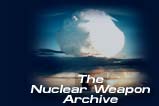 Projects 57, 58, and 58A Projects 57, 58, and 58A
1957 - 1958: Nevada Test Site
The advent of compact, light weight, low maintenance nuclear weapons had important implications for weapon safety. In the days of large, heavy fission bombs the possibility of dangerous nuclear reactions being initiated by accident could be minimized by preventing the final assembly of the bomb from occuring until just before actual use. This was accomplished by requiring actual assembly of the bomb from its components just before the mission (as with the original Fat Man design); by having a "trap door" in the bomb so that the fissile material could be inserted just before flight or even in-flight; or by equipping the bomb with automatic in-flight insertion mechanisms -- electric motors that moved the bomb core and high explosives into their operational configuration.
But light, compact, low maintenance weapons did not have the space for these sorts of arrangements, and separate handling of internal bomb components by field personnel was very undesirable from the standpoint of ease of use and reliability. Instead "sealed pit" designs were adopted in which all parts of the fission bomb -- the fissile material, tamper, reflector, high explosive, etc. -- were placed in their final configuration when the bomb was assembled in the factory. This raised the possibility that accidental detonation of the high explosive could compress the core to supercriticality and bring about hazardous releases of nuclear energy. Such an accident would presumably result in yields far below the actual weapon design, but even very low yields could result in catastrophic effects on nearby personnel and facilities. A fission yield of only a few tons can produce lethal radiation out to distances of several hundred meters.
Safety tests were clearly needed to evaluate the safety of these new sealed pit designs. The inherent safety margins were small, and it was impossible to precisely calculate what would happen in an asymmetrical detonation such as could occur in an accident. The standard that was adopted was the fission device must be "one point safe". In other words, the initiation of the high explosive at one point (in contrast to the simultaneous multi-point detoantion of a proper implosion) could not cause a detectable release of nuclear energy (the result must be "zero yield"). Also of interest was the extent of the plutonium contamination hazard in the event of an accidental detonation, even with no nuclear energy release.
The first safety tests were known as Project 56 conducted in 1955 (of four shots, one failed - producing a yield of some tens of tons). In 1957 and 1958 three more limited test programs were conducted: Project 57, Project 58, and Project 58A. These three programs included a total of five test shots, most of them them producing some sort of nuclear yield (one an astonishing 500 tons). All three programs are discussed on this page. |
Project 57| Test: | Project 57 No. 1 |
|---|
| Time: | 14:27 24 April 1957 (GMT)
|
|---|
| Location: | Nevada Test Site, Area 13 |
|---|
| Test Height and Type: | Surface burst |
|---|
| Yield: | Zero |
|---|
This was an AEC-sponsored plutonium contamination hazard test of the XW-25 air defense warhead, which was expected to be widely deployed in large numbers, even within urban population centers. The warhead contained plutonium and depleted uranium. No nuclear energy release occurred. The warhead was 17.4 inches by 26.7 inches long, and weighed 218 lb. It contained about 100 lb. of high explosives.
Project 58| Test: | Pascal-C |
|---|
| Time: | 20:15 6 December 1957 (GMT)
|
|---|
| Location: | Nevada Test Site, Area 3e |
|---|
| Test Height and Type: | Underground burst in shaft, -250 feet |
|---|
| Yield: | Slight |
|---|
Los Alamos one-point safety test of device scheduled for firing in Operation Hardtack. Similar to Hardtack II Valencia and Hardtack II San Juan devices. Possible XW-42 test. The device was 13 inches in diameter, 17.3 inches long, and weighed 92.9 lb. | Test: | Coulomb-C |
|---|
| Time: | 20:00 9 December 1957 (GMT)
|
|---|
| Location: | Nevada Test Site, Area 3i |
|---|
| Test Height and Type: | Surface burst |
|---|
| Yield: | 500 Tons |
|---|
Los Alamos one-point safety test of device scheduled for firing in Operation Hardtack. This a deliberate overtest that was actually intended to produce a nuclear yield. This established an upper bound on 1-point safety limits. Similar to the Moccasin device fired in Hardtack II Hidalgo. The device was 22.2 inches by 22.2 inches, and weighed 383 lb.
Project 58A| Test: | Venus |
|---|
| Time: | 01:00 22 February 1958 (GMT)
|
|---|
| Location: | Nevada Test Site, Area 12 |
|---|
| Test Height and Type: | Underground burst in tunnel, -100 feet |
|---|
| Yield: | Less than 1 ton |
|---|
Lawrence Livermore one-point safety test of device scheduled for firing in Operation Hardtack. Similar to Hardtack II Oberon and Sanford devices. Possible XW-47 primary candidate. Device dimensions were diameter 12.8 inches, length 14.7 inches, weight was 114 lb. | Test: | Uranus |
|---|
| Time: | 22:00 14 March 1958 (GMT)
|
|---|
| Location: | Nevada Test Site, Area 12 |
|---|
| Test Height and Type: | Underground burst in tunnel, -114 feet |
|---|
| Yield: | Less than 1 ton |
|---|
Lawrence Livermore one-point safety test of XW-48 warhead. This was a plutonium linear implosion warhead for a 155 mm artillery shell. Similar to devices fired in Hardtack II Mars, Tamalpais, and Ceres. Possible XW-47 primary candidate. Device was 21.1 inches long and weighed 111 lb.
 << BACK << BACK
|



